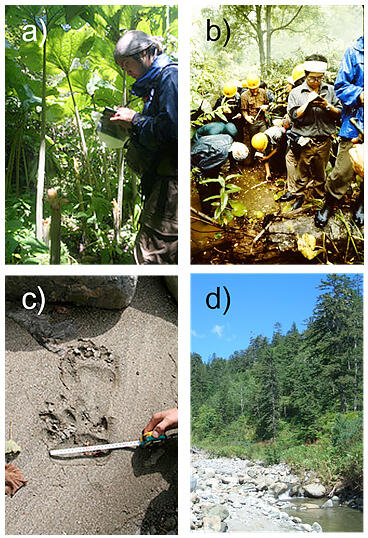On August 27, the research group of Professor Futoshi Nakamura, Graduate School of Agriculture, Hokkaido University; Takafumi Hino, Researcher, Northern Biosphere Field Science Center, Hokkaido University (currently Research Staff, Industrial Technology and Environment Research Headquarters, Hokkaido University Research Organization); and Takahiro Kubo, Senior Researcher, Biodiversity Area, National Institute for Environmental Studies, announced that they had completed an analysis of the brown bear population decline and recovery using 40-year monitoring data, obtained by the Brown Bear Research Group of Hokkaido University (Hokkaido University Bear Research Group), a student circle investigating brown bears in Hokkaido. The group found that the population decrease that occurred during the spring bear culling period in Hokkaido from 1969 to 1990 had been recovered since this system was abolished. This achievement is expected to enable the protection and management of other large carnivores. These results were published in the international scientific journal Conservation Science and Practice.
The numbers of many Carnivora taxa are declining worldwide because of human interference and understanding long-term population fluctuations is important for detecting the effects of human activity on long lived, large carnivores. The Hokkaido University Bear Research Group was initially formed in 1970 by volunteer students at Hokkaido University, and has been conducting a survey of brown bear populations since 1975 at the Teshio Experimental Forest (approximately 225 km2), located at the northern end of the brown bear habitat in Hokkaido. A fixed route--established along rivers and forest roads typically used by brown bears, covering the entire Teshio Experimental Forest--is surveyed every summer, and traces of brown bears (feces, footprints) are recorded. From 1969 to 1990, a system to actively control bear populations in Hokkaido was enforced, under which bears were easily and unrestrictedly captured in early spring, while no monitoring was performed. In 2015, this policy changed, and a "countermeasure training of engineers for capturing brown bears" effort was established in early spring to develop human resources for brown bear countermeasures. Since then, the upper limit of males and females caught, and the catch area have been set for each region based on monitoring data of the populations. Moreover, the current policy is to avoid catching parents and cubs whenever possible.
To statistically analyze 40 years (1975-2015) of records on paper media, the survey area was subdivided into 1 km22 grid cells using geographic information system, and the presence/absence of individuals' traces was converted into digital data. To investigate population changes over time, a long term analysis was performed using a state-space model and the trace detection rate (a population index) during the "spring bear culling system period" (1975-1990) and "after the culling system was abolished" (1991-2015). The rate of trace discovery (indicator of bear abundance) during the spring bear control system period declined approximately 15% per year, until the late 1980s, when almost no evidence of bears was found. However, after the system was abolished in 1991, the rate of trace discovery began to increase (approximately 7% per year), and the population appeared to recover. Although the traces are not necessarily correlated with population size, a trend was confirmed. The activity ranges of male and female brown bears reach several hundred square kilometers and several tens of square kilometers, respectively; meaning that it is unlikely that the bears live only within Teshio Experimental Forest.

(Photograph A and C provided by Hirofumi Hara, B by Maki Yamamoto)
As the Sea of Japan side of northern Hokkaido, including the Teshio Research Forest, is an area of heavy snowfall, it is believed that the efficiency of the spring bear culling system was high. The recovery of the brown bear population after the abolition of the system was thought to be due to the transfer of individuals from the continuous forests that form the brown bear habitat and are connected to the southeastern part of the Teshio Research Forest.
To date, the information on the distribution and population of brown bears in Hokkaido has been provided by hunters and other people; however, the aging population and the shortage of workers have become issues. Students activities as scientists may play an important role in future wildlife conservation management. Insights from continued monitoring are expected to assist in the reduction of conflicts between bears and people.
All authors of the paper, except Professor Nakamura, are alumni of the Hokkaido University Bear Research Institute. According to Mr. Hino, "Monitoring is like an annual health check. I hope it can be used to clarify whether the brown bear population will continue to increase in the future. The data used in this study is from a limited area, so we would like to compare it with other brown bear habitats in the future."
This article has been translated by JST with permission from The Science News Ltd.(https://sci-news.co.jp/). Unauthorized reproduction of the article and photographs is prohibited.




